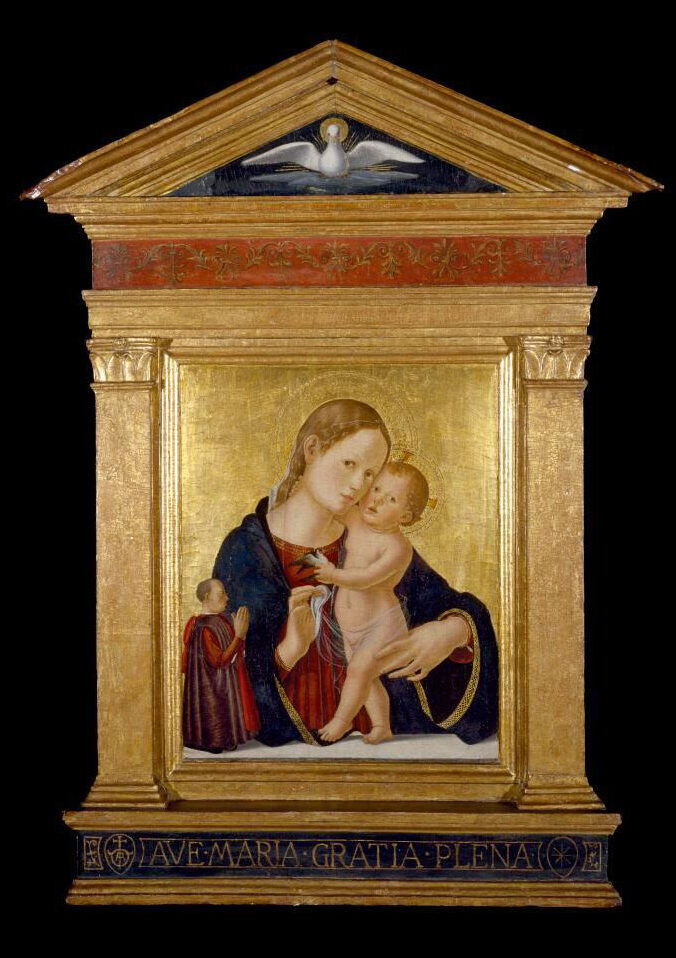
Antoniazzo Romano, Virgin and Child with a Donor, c. 1480, tempera and gold leaf on panel, 47.1 x 37.8 cm (Museum of Fine Arts, Houston)
Everyone recognizes recurring trends as retro styles in fashion and design. Case in point: the current popularity of Polaroid cameras, “mom jeans,” old sitcoms, and other cultural relics from generations past. The new and cutting-edge only constitutes part of a consumer culture that demands the past mingle with the present. The same is true of Renaissance art in Italy, as exhibited in the retro style of the painter Antoniazzo Romano. His working career, from the 1460s to the 1490s, was nearly contemporary with more celebrated artists like Botticelli, Leonardo da Vinci, Raphael, and Michelangelo. Yet his works persistently recall certain traits of medieval paintings—gold backgrounds, stamped decorative detailing, simplified compositions, and frontal figural arrangements—that other artists rejected as old-fashioned.
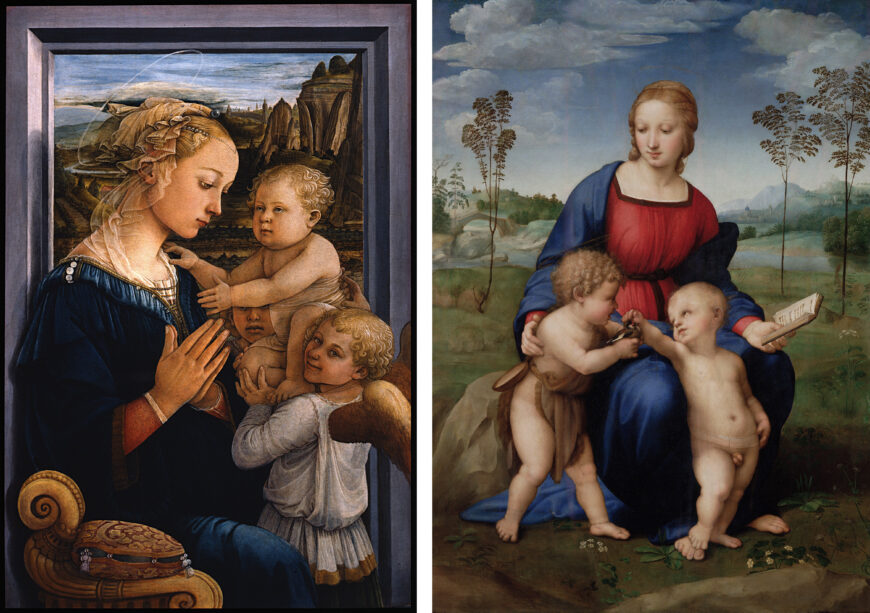
Left: Fra Filippo Lippi, Madonna and Child with two Angels, c. 1460–65, tempera on panel, 95 x 63.5 cm (Uffizi Gallery, Florence); right: Raphael, Madonna of the Goldfinch, 1505–06, oil on panel, 107 x 77 cm (Uffizi Gallery, Florence)
New and old fashions
Antoniazzo Romano’s retro style is evident when compared to other Renaissance artists. Fra Filippo Lippi’s Madonna and Child with Two Angels humanizes Mary as she tenderly clasps her hands in prayer while Christ, rendered as a chubby toddler, turns lovingly towards her. All figures are activated and turned in space. Through the open window behind we see an unfolding landscape. Raphael’s Madonna of the Goldfinch builds upon Lippi by softening the contours of the figures with delicate modeling and imbuing them with graceful and calm demeanors. Further, Mary, Jesus, and Saint John the Baptist are set in a warmly lit and fully articulated outdoor setting that is carefully and realistically rendered. Both Lippi and Raphael show off new artistic achievements in striving for greater naturalistic renderings.
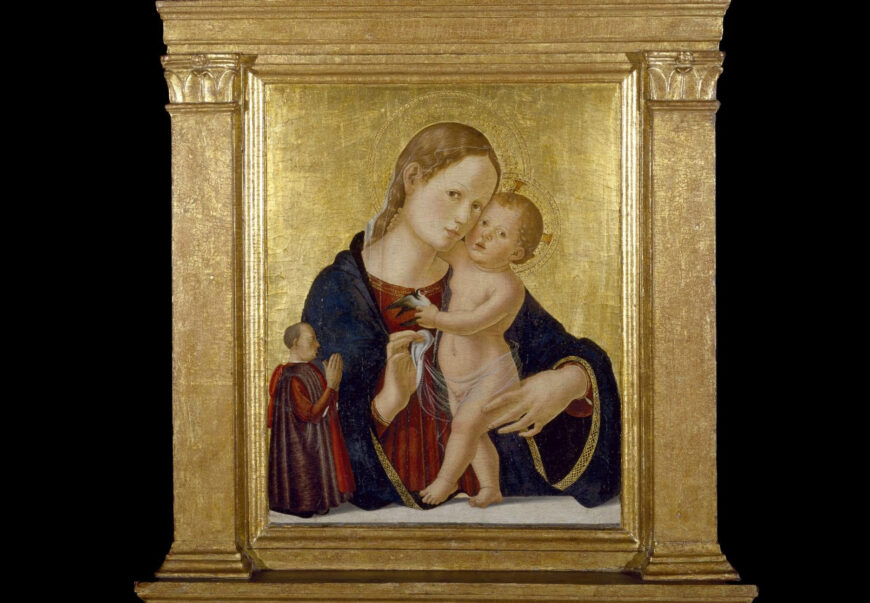
Virgin and child (detail), Antoniazzo Romano, Virgin and Child with a Donor, c. 1480, tempera and gold leaf on panel, 47.1 x 37.8 cm (Museum of Fine Arts, Houston)
By contrast, Antoniazzo Romano’s Virgin and Child with a Donor mixes elements of new and old styles. We do see some of the traits that mark Lippi’s and Raphael’s painted Madonnas, like the attention to delicate naturalistic features and the tenderness with which she nuzzles the Christ Child. But other changes signal Antoniazzo’s intentional desire to evoke older artistic forms from the 1300s and earlier. He restricted his composition to the figures alone, and rendered them in simpler and more frontal postures. Even more prominent is the gold background that at this stage of the Renaissance was almost entirely out of fashion. In this regard, his painting harkens back to Duccio’s late-gothic gilded Madonnas, themselves modeled on older styles.
The functions of all these images of the Madonna and Child to inspire religious devotion remained constant. But their manners of representation signal that there is not always a one-to-one relationship of style to a single historical moment. An artist like Romano working in the late 1400s is capable of borrowing visible features as much from the past as from the present—not unlike designers of clothing, and other products made today.
Medieval revival
Antoniazzo Romano’s retro style emerged during the Byzantine revival in Rome. Though the import of West Asian culture and artifacts into the West goes back centuries, the influx of Byzantine art into Rome increased after the fall of the Byzantine Empire in 1453. This resulted in increased interest in and demand for images modeled after medieval icons both for private and church settings. Even if those icons were later copies, they could be revered for their originary ties to early Christianity.
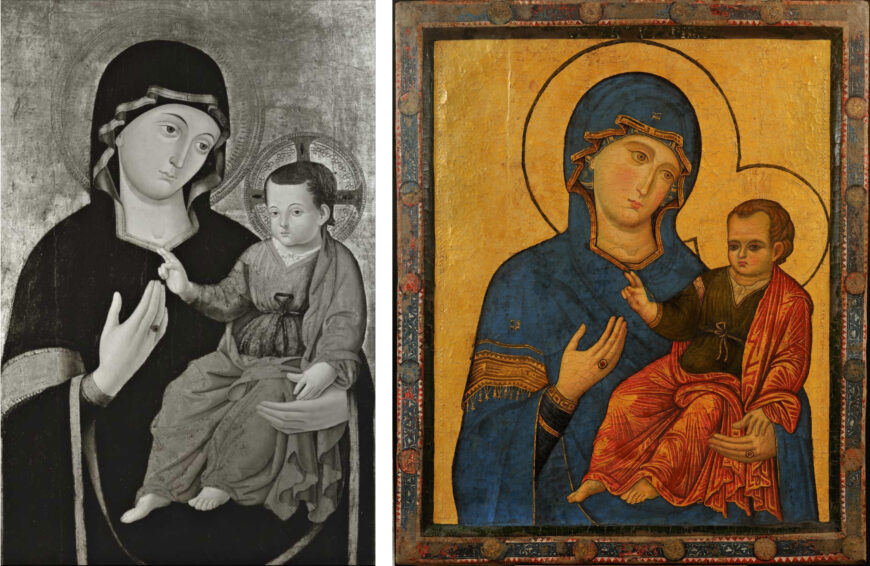
Left: Antoniazzo Romano, Madonna and Child, late 15th century, tempera on wood, 109 x 77.5 cm (Parrish Art Museum, Water Mill, NY); right: Icon of Madonna del Popolo, c. 13th century, tempera on panel (Santa Maria del Popolo, Rome)
Sometimes Antoniazzo copied particular medieval icons. His Madonna and Child at the Parrish Art Museum in Water Mill, NY is one of a number that replicate the 13th-century Madonna del Popolo in the church of the same name in Rome. By the 1400s that icon was regarded as a much older authentic painting by Saint Luke. Antoniazzo maintained the older image’s figural and spatial flatness, the frontality of the bust-length Mary and Jesus, and the richness of its decorative gold leaf.
Left: Icon of Christ, known as the Uronica, Sancta Sanctorum, Saint John Lateran, Rome (photo: Sailko, CC BY 3.0); Antoniazzo Romano, Bust of Christ, c. 1495, tempera and gold on panel, 87 x 62 cm (Museo del Prado, Madrid)
Another, the Bust of Christ, copies the icon of Christ at the Sancta Sanctorum in Rome. This icon was also believed to have been painted by Saint Luke but finished by an angel. Its style was what convinced people that it was very old. Its severe frontal rendering of Christ’s face, staring out with large almond-shaped eyes, were (and still are) hallmarks of its ancient age. Even while Antoniazzo Romano embellished these copies with traits borrowed from his Renaissance contemporaries—he enlivened the faces and rendered them more realistic through soft light and shadow—the works’ appeal was their unmistakable resemblance to the older medieval models.
Retro style meets modern manner
Antoniazzo Romano shows us that Renaissance artists were capable of choosing styles from a variety of periods rather than sticking with the newest and most recent modes of pictorial representations. Take, for instance, his frescoes in the apse of Santa Croce in Gerusalemme. This church was one of Rome’s primary sites for pilgrimage thanks to its collection of holy Christian relics brought to Rome by Emperor Constantine’s mother, Saint Helen.
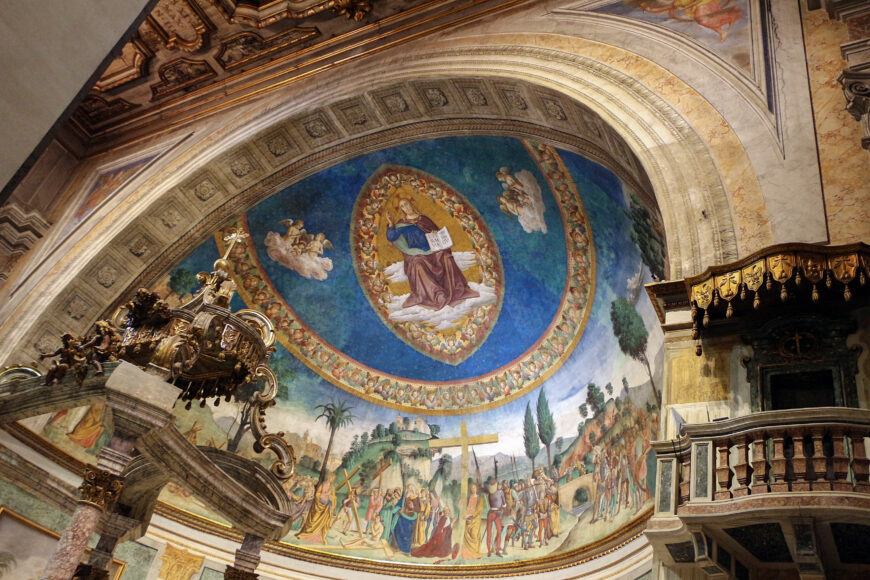
Antoniazzo Romano, apse of Santa Croce in Gerusalemme, c. 1492–95, Rome (photo: Sailko, CC BY 3.0)
Apse imagery has a long history in Rome, where medieval examples in mosaic testify to the styles and mediums common before the Renaissance. Antoniazzo Romano’s apse fresco formed part of an extensive renovation of this early Christian basilica and surely replaced an older one. The lower part shows Saint Helen’s recovery of the True Cross. Figures in realistic poses act out the scene in a legible narrative and are set against a daylit landscape replete with atmospheric perspective. But the apse painting above looks quite different. There we see a flat background of regularly arranged stars. In the center Christ sits enthroned in majesty surrounded by a golden mandorla and presented in a strict and monumental frontality that conveys his authority as ruler of the world.
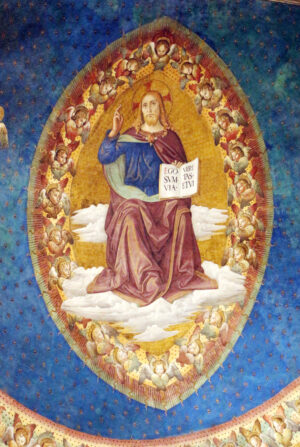
Mandorla (detail), Antoniazzo Romano, apse of Santa Croce in Gerusalemme, Rome (photo: Sailko, CC BY 3.0)
Here Antoniazzo Romano puts different styles in confrontation. While the narrative below is typical of the late 15th century, Christ harkens back to medieval figural styles. While the Christ in Majesty was informed by Renaissance treatments of the body and the drapery that covers it, its stark almost frozen frontality recalls images of Christ Pantokrator (or Christ All Powerful) in medieval icons and mosaics, such as at the Cappella Palatina in Palermo. Further, no existing medieval image in Rome features Christ in a mandorla. This motif was instead more common in the eastern Byzantine empire. In other words, unlike the icons of the Madonna and Christ discussed above, this is not a copy of a particular medieval image. It is a new image, but adopts a retro style recalling the legacy of the antique.
An alternative Renaissance
The history of Renaissance art in Italy is often, unfortunately, told as the vanquishing of medieval art. Yet this excludes the painters, patrons, and viewers who desired retro artistic styles. Antoniazzo Romano was not alone in catering to those tastes. Greek painters in Venice and Venetian Crete in the 1400s and 1500s also mixed Renaissance and Byzantine styles. But these are only representative of a much larger alternative to our modern cannon of the Italian Renaissance whose prioritizing of new naturalistic renderings of figures and settings has excluded artists like Antoniazzo Romano. Consequently, to uphold artists like Raphael as the epitome of the Renaissance is to blindly adhere to the legacy of Giorgio Vasari whose categorization of the period and whose tastes for certain artistic traits over others has fundamentally shaped the field of Renaissance art history. In reality, this was not just an age of forward-looking artistic innovation. Rather, much like trends in fashion and design today, Renaissance painting experienced recurring fads for retro medieval imagery and a persistent valorization of past styles as well.
Additional resources
Greek Painters in Renaissance Venice
Anna Cavallaro, Antoniazzo Romano e gli Antoniazzeschi: Una generazione di pittori nella Roma del Quattrocento (Udine: Campanotto, 1992).
Meredith J. Gill, “Antoniazzo Romano and the Recovery of Jerusalem in Late Fifteenth-Century Rome,” Storia dell’Arte, volume 83 (1995), pp. 28–47.
Alexander Nagel and Christopher Wood, Anachronic Renaissance (Brooklyn: Zone Books, 2010).

